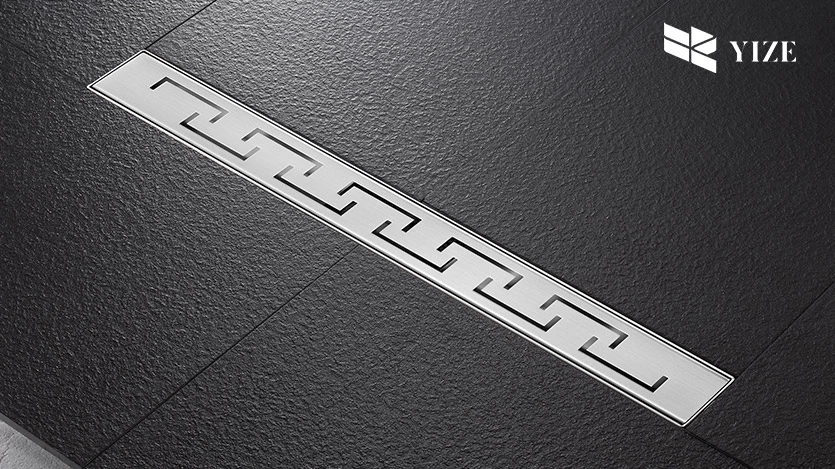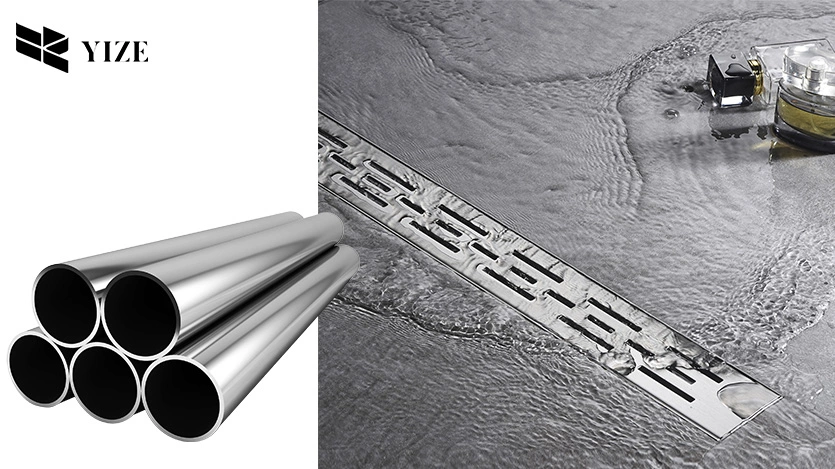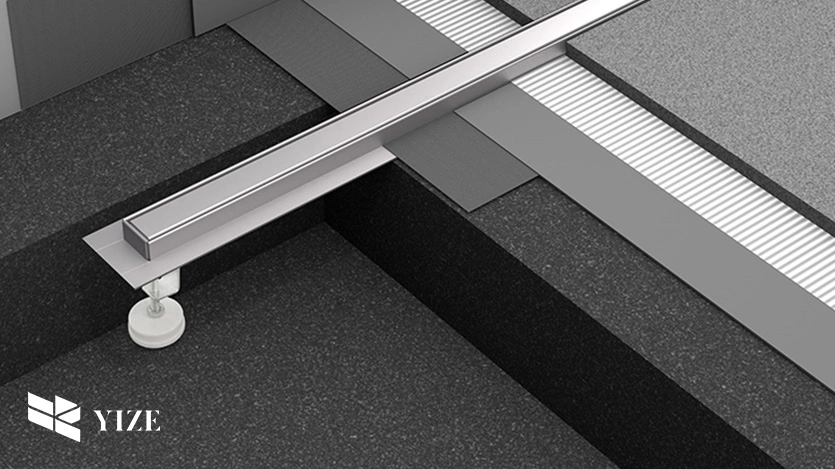
I. Introduction
A linear shower drain is a continuous drain strip placed along one side of the shower enclosure or area providing a current chic design instead of the circular central drain. Linear shower drains are becoming more sought after because of the efficiency they provide in handling the shower water flow, the aesthetic and sleek design, and the lack of curbs in barrier-free showers. Super important, however, is the correct choice of length since its choice increases the usability and attractiveness of the link.
In this guide, you will find out how to calculate the dimensions of your shower correctly, what you need to know about drain, and how to make aesthetical choices concerning the length of an ideal linear shower drain. A good drain also means that water drains well, the shower floor does not get flooded, and the drain matches the designed layout of your bathroom.
II. Understanding the Functionality of a Linear Shower Drain
A linear shower drain means a drain which runs in a centrally aligned line surrounding the shower area or along the shower wall or floor. While round drains installed in the middle of the shower, linear shower drains are more discreet and efficient as the drainage systems. These drains are perfect for the contemporary bathroom and are well suited to the walk in shower and wet room.
1. Overview of the Role of a Linear Drain in Efficient Water Drainage
The major role of a linear shower drain is the transportation of water on the shower floor to the plumbing system. The linear characteristic gives room for water to be collected in a longer area, which will not allow the formation of a water bin on the floor. This makes it easy for drainage to take place, and in the case of showers, it should do this faster, especially for big shower areas. A linear drain works to keep the shower space safe and dry because it provides a series of inclines towards the drain.
2. Key Benefits of Using a Linear Drain
- Aesthetic Appeal: It forms a linear patterned shower drain and is almost invisible when installed, and adds value to the layout of the bathroom.
- Improved Water Flow: Explaining the differences between linear drains and conventional shower drains Linear drains are more efficient with regards to water drainage and have minimal likelihood of a shower flooding or water build up.
- Versatility: These can also be installed along the wall or floor in the middle of the room giving flexibility in shower design.
III. How to Determine the Required Length of a Linear Shower Drain
1. Measure the Shower Area
Step one in order to establish the right length of the linear shower drain is to take some measurement of the shower space to be drained. The size of the shower drain to be installed determines by the length of the floor of the shower area. For larger showers you might need a bigger drain pipe to help handle the water that is coming through it.
2. Drainage Requirements
You should think of how many gallons of water you normally use to shower. If it is larger for example as applied in baths, then you will require a longer line of the shower drain so that water does not compound on one particular area. For efficient drainage features, the drain must extend over a significant area of the shower floor to decrease the potentiality fro flooring.
3. Type of Shower Design
It is important that all shower designs are fitted with different drainage lengths and styles. For instance, in an open planned walk n shower or a wet area where the entire floor plan is uncovered, a comparatively larger linear shower drain might suffice. On the other hand, a heavily populated shower may require a longer drain, while a small compact shower can be done with a short one.
4. Drain Placement and Aesthetic Considerations
The other factor that determines the length of the linear shower drain is its position. While opting for wall mounting, you may require a longer pip,e while other placements may let you settle with short pipes. Also, think about what the general look of the bathroom will be and how a drain will complement the rest of the fixtures.
IV. What to Consider When Specifying a Linear Drain

1. Drain Material and Durability
Choosing the material for your linear shower drain will out rightly determine how durable it will be. The most popular material is stainless steel since it does not corrode easily as other types of steels. Select a material that would not ease out focusing on the lifespan of the material to resist moisture and even cleaning products.
2. Floor Slope and Drain Slope
The setting of the shower floor and the linear shower drain is expected to be slanting and that slope must be appropriate so that it will allow water to flow freely to the drain. Miniscutia: it is encouraged for the area around the drain to have a little more inclination to ensure that water does not clot or stagnate.
3. Grate Design and Style
The grate design also affects the look of the linear shower drain. The grate may be as simple as a frame-less rectangular opening or a detailed patterned work of art; it must match the general décor of the bathroom. Different materials are available: stainless steel or finished to the desired color to match the interior of the bathroom.
4. Installation Accessibility
Also, think about how simple it might be to put in a linear drain. Its simplicity ranges from having already integrated solutions when implemented to systems that need more comprehensive integration. Always ensure that you select the most appropriate drain system that you are at a capacity of installing.
V. How to Install a Linear Shower Drain System
1. Preparation
Before installing the shower base it is advisable to first prepare the shower floor well. This entails; leveling of the surface, the general floor inclination towards the drain amongst others.
2. Step-by-Step Installation Process
- Install the Drain Base: Lay the linear shower drain into its proper position on the base where you wish to have the shower in the bathroom.
- Attach the Drain: Use the suitable fixings to fix the drain and let the water to provide the pipe’s appropriate running.
- Install the Grate: After the installation of the drain base, then the grate should be placed on top and fixed firmly.
- Seal and Test: Tighten all seams and check how the water passes through it.
3. Common Installation Pitfalls to Avoid
- Proper Schlitt surface of the floor toward the drain is not done.
- Using a smaller drain size than the size of the shower is going to be.
- Failure to tighten the drain properly and may wear out and produce leaks.
VI. Factors Affecting the Length of the Linear Drain

1. Shower Size and Water Flow
The size of the shower area, i.e., linear shower drain length, and the volume of water used will affect it. Larger showers which have a high flow rate require a longer period to drain off the water that stands on the shower base..
2. Shower Floor Layout
The length of drain that is required depends on the shower flooring. The type and size of the layout may be wider or complex, and in order to provide an efficient drainage to the entire layout, may necessitate a longer drain.
3. Design Preferences and Functionality
If you prefer having a shower drain installed without much exposure, then having a longer linear shower drain will suit the best. However, simplicity and attractiveness cannot be taken to the extreme – the ratio between form and content has to be used here.
VII. How to Choose the Right Linear Drain Length Based on Shower Type
1. Standard Shower Configurations
For general shower designs, a linear shower drain that should span not less 50-70% of the total length of the shower floor is regularly adequate.
2. Wet Rooms and Walk-In Showers
In the case of large open plan shower zones for example wet rooms, inventory requires the use of a more extensive linear shower drain capable of managing the flow at the floor level throughout the entire area in question.
3. Large Showers and Luxury Bathrooms
In tall showers where a shower head has a wider shower space, a longer linear shower drain is more appropriate to accommodate the additional water volume.
VIII. Common Mistakes to Avoid When Determining Linear Drain Length
1. Choosing a Drain that is Too Short or Too Long
Being denied a good water drainage means that one has chosen the wrong length. Be sure to take a correct measurement of the shower area and go for a drain that has enough coverage so that water flows freely.
2. Failing to Account for Proper Drainage Slope
SHARP or incline towards the discharge line is necessary in order to move water effectively. Failure to consider slope might result to formation of pools of water and eventual formation of watery drainage systems.
3. Ignoring Maintenance Considerations
Drains that are relatively long may thus have to be cleaned a number of times and at an earlier time than the short ones. Think about how difficult it is going to be to clean your selected linear shower drain length in the future.
4. Overlooking Compatibility with Overall Bathroom Design
When considering the type of shower drain to select, linear shower drain should be chosen to match the general design and floor plan of your bathroom. Get the drain style right in the sense that it should be what you prefer most aesthetically.
IX. Where to Buy the Best Shower Drain Supplier?
The best linear shower drain brands are YZDRAIN because of the quality material they use, their reliability and how beautiful their shower drains are.
X. Why Choose YZDRAIN?
- High-Quality Standards: YZDRAIN also employs the premier material stainless steel to produce long-lasting and corrosion solutions.
- Durability Solutions: YZDRAIN provides dependable solutions which are long lasting with smooth water flow passage and easy maintenance.
- Customer Feedback: Buyers appreciate the convenience of using YZDRAIN, the attractive appearance and fast assembly.
XI. Conclusion
Linear shower drain choice depends much on the length of the shower drain chosen for ease and aesthetic value. Due to this, when deciding on the length of the shower, factors such as shower size and intended drain, as well as the general design preferences, will dictate the best length to go for. YZDRAIN has quality products that are long-lasting and very easy to install – this makes it easy to accomplish this. However, to get the best of it is advisable to consult a professional installer for a good fit and good performance.
Frequently Asked Questions (FAQs)
1. How do I determine the correct linear shower drain length for my shower?
Area for the shower and water flow; the ideal linear shower drain without clogging should occupy 50% to 70% of the entire space for showering.
2. What factors affect the linear shower drain length?
Size of the shower, the floor pattern and design effects are some of the considerations that need to be made when planning for a correct linear shower drain length for water flow.
3. Why is the length of a linear shower drain so important?
Choosing the right length of a linear shower drain is critical to its efficiency, avoids standing water and adds beauty to your shower.
